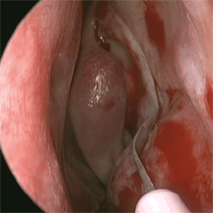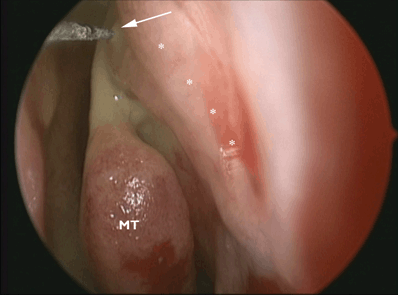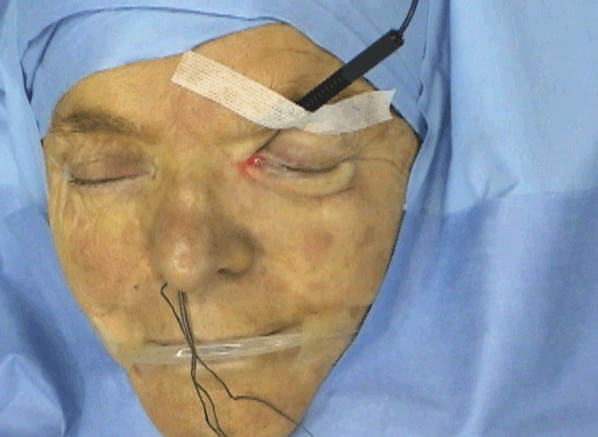Endoscopic Dacryocystorhinostomy

Endoscopic dacryocystorhinostomy (EndoDCR) is a surgical procedure performed through an endonasal approach to the lacrimal sac with a camera-mounted endoscope. Like conventional DCR, it aims to form a permanent opening of the lacrimal sac and duct into the nose, bypassing the obstructed portion of the nasolacrimal duct. It is performed most commonly when a complete or partial nasolacrimal duct obstruction is present but can also be used to prevent recurrent dacryocystitis. It can also be performed when an acute dacryocystitis is present after systemic antibiotics have been initiated even in the presence of residual inflammation and swelling.
PREOPERATIVE EVALUATION AND PREPARATION
A detailed medical history should include previous surgeries involving the lacrimal system, the nose, and the paranasal sinuses. Proper imaging with a computed tomography scan is obtained if a history of trauma with possible naso-orbital fracture is disclosed. Bone deformities or hardware used to reduce the fracture may hamper access to the sac from an endoscopic approach. History of abnormal bleeding is investigated. Anticoagulants including aspirin should be stopped before surgery for a period long enough to reverse its effect and not be resumed for 5 days following surgery. If for medical reasons the discontinuation of anticoagulants cannot be done, an alternative approach should be considered.
A bone subtraction dacryocystography may be obtained when a partial obstruction is present, in cases of recurrent dacryocystitis and when a diverticulum is suspected. Careful examination of the nose is mandatory before surgery. Ideally, an endoscopic evaluation of the nasal cavity is performed in the clinic. It allows the surgeon to determine if sufficient space is present to perform the endoscopic surgery. When available space is limited, a general anesthesia may be proposed or an external approach may be preferred. Nasal endoscopy may also disclose the presence of nasal anomalies including tumor, polyps, septal deviations, and nasal mucosal inflammation or synechiae.
Probing of the canalicular system should be performed. Obstruction of the common canaliculus is a contraindication to endonasal surgery and an external canaliculodacryocystorhinostomy (CanaliculoDCR) should be considered. When diffuse canalicular scarring is present, placement of a Jones tube is the best solution and can be performed endoscopically.
Surgical setup and anesthesia
The surgery can be performed under local anesthesia with sedation in most patients. General anesthesia is preferred if the surgical access is restricted or if for various reasons the collaboration of the patient cannot be obtained. Proper monitoring including oxygen saturation measurement should be available. The patient is in supine position with a moderate inclination from head to toe of about 20° to 30°. A solution of lidocaine 4% with epinephrine 0.25% spray is applied to the nostril 5 minutes before injection to minimize pain at the time of local infiltration. A solution of cocaine 4% is also an alternative.

Figure 25-1. Endoscopic view of the injection of the insertion of the middle turbinate. (MT : Middle Turbinate. White arrow points to injection at insertion of middle turbinate. White asterisk show sites of injection along the frontal process of the maxilla). Using a nasal speculum and a headlight, the lateral wall of the nose is infiltrated in the area of the uncinate process and along the frontal process of the maxilla. The insertion and the turbinate itself are also infiltrated, and the area above can also be injected. The nose is packed gently with neurosurgical cottonoids soaked in lidocaine 4% with phenylephrine 0.25%. When surgery is performed under local anesthesia, the packing should include the opening of the nostril to ensure proper anesthesia of the tip of the nose. If this is still sensitive at the time of surgery, a small infiltration of the mucosa of the septum in this area can be done. When surgery is performed under local anesthesia, an infiltration of anesthetic is delivered to the medial canthal area, lacrimal sac area, and the anterior ethmoidal nerve from the orbital side. This step is not necessary under general anesthesia.
Surgery

Figure 25-2. Transillumination probe in the upper canaliculus. The upper punctum is gently dilated with a punctal dilator and a 20-gauge fiberoptic probe (retinal endoilluminator 20 gauge made by Alcon) is inserted horizontally in the upper canaliculus and fixed to the forehead of the patient at a 45°π angle with a Steri-strip.
Stay updated, free articles. Join our Telegram channel

Full access? Get Clinical Tree


